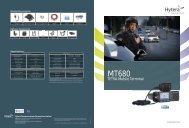G S Kok, Hytera's vice-president for subscriber terminals, talks to ...
G S Kok, Hytera's vice-president for subscriber terminals, talks to ...
G S Kok, Hytera's vice-president for subscriber terminals, talks to ...
You also want an ePaper? Increase the reach of your titles
YUMPU automatically turns print PDFs into web optimized ePapers that Google loves.
Tier III trunkingcomed by the firefighters is its digital voice encryptioncapability. “Hytera has one of the bestencryption pro<strong>to</strong>cols in the market becauseyou can have, on DMR, three scenarios: 16bits, 128 and 256 bits”, comments Mr Scott.“We’ve given them the capacity <strong>to</strong> change theirown keys by themselves. This way, the clienthimself is able <strong>to</strong> control the privacy in theircommunications.”Traffic loadingA conventional, one-slot trunking system cansupport up <strong>to</strong> 45 radios and three or four companyfleets, Mr Scott finds, although even thatmodest level of loading can lead <strong>to</strong> contention.“On pseudo-trunking, you can actually pumpthe system up <strong>to</strong> 75 units and have about 6–7companies operating with almost no collisionswhatsoever”, he says. “But here is one of thefac<strong>to</strong>rs that made a big difference with Hytera.Pseudo-trunking gave us an edge on loading capabilitieswith our clients.“Obviously you have <strong>to</strong> be very efficient inchoosing, because you cannot choose two taxicompanies on the same system, because theyare going <strong>to</strong> flood it! But you have <strong>to</strong> mix andmatch and be very comprehensive upon thetype of client you are going <strong>to</strong> use with thepseudo-trunking system.”Connecting with IPAnother Hytera system feature he values is theability <strong>to</strong> interconnect repeaters using IP datalinks, enabling wide-area coverage <strong>to</strong> be providedsimply. “Once you operate pseudo-trunkingDMR Tier III: new network equipmentdelivered <strong>to</strong> Guatemala by HyteraDriver’s radio in a Transurbano bus, a harsh environment <strong>for</strong> mobile communications.But dust and vibration are not the only hazard in Central America: Crelosa reportsthat a number of Hytera radios were inundated in flood waters after a recent tropicals<strong>to</strong>rm, some of them <strong>to</strong> a depth of more than one metre, but all of them survivedsingle-site, the first thing that your client wantsthen is more coverage”, he explains. “Thatmeans that you have <strong>to</strong> install repeaters.“The interesting part here is that the Hyteraproduct has the au<strong>to</strong>matic roaming capabilityinstalled in<strong>to</strong> the system, without an extra option.When we buy from the fac<strong>to</strong>ry, it comesin with all the bells and whistles, so it’s easier<strong>for</strong> us just <strong>to</strong> program whatever we need.“But the scenario of roaming works reallywell. Here’s an interesting hint: there is somethingcalled beacon programming on the repeater.It means that if no one is speaking – ifthere’s no traffic flowing through that repeater– the repeater has <strong>to</strong> have a beacon <strong>to</strong> tell anyradio scanning on DMR that the repeater ison, and it’s working and it’s ready <strong>to</strong> receivesignals. This way, the radio can actually do theroaming in<strong>to</strong> that site.“That is a big tip”, he laughs. “Either youhave a client who actually uses a repeater sothat the radio can find it, or you do your beaconvery often.”But he continues: “DMR wide-area networkinghas a wonderful capacity <strong>for</strong> managementand administration, simply because youare able <strong>to</strong> program all the repeaters on the radio.You can even tell it that, <strong>for</strong> example, yourradio can only access Repeaters 1, 2 and 3 – not4, 5 and 6. We can do that. And if you want 1,5, 6 – not a problem.“If the radio gets s<strong>to</strong>len, we can turn it off,or radio-kill. We can take that ID off the system,so he will not be able <strong>to</strong> get in<strong>to</strong> the systemand communicate.Split affectionsFor Crelosa, a very special feature of Hytera’sDMR radios is their support <strong>for</strong> unconventionaltransmit/receive frequency splits. These are commonlyrequired in Guatemala and other CentralAmerican countries, in place of the tidy 10 MHzor 5 MHz splits usual in Europe. “Specifically,<strong>for</strong> Guatemala, you’d sometimes get 1 MHzwhile sometimes you get 3 MHz and sometimesyou get 10 MHz”, Mr Scott observes. “Well, myfriend, welcome <strong>to</strong> Guatemala.”The solution <strong>to</strong> this problem, he continues,is simple enough: you approach your radiomanufacturer and you ask them <strong>to</strong> changetheir entire programming scheme.“Well, Hytera did it”, he adds. “And Hytera,in version 2.0, will have that difficult channelsplit. For that, with humility, I have <strong>to</strong> thankthe people at Hytera, because they have beenlistening <strong>to</strong> me.”And he ends: “I have fallen in love withHytera because of the way Hytera works – theybring you in<strong>to</strong> a family. That’s very difficult <strong>for</strong>me <strong>to</strong> explain, but it’s a family feeling thatreally pushes you <strong>for</strong>ward in<strong>to</strong> much, muchmore than a business relationship. I have hadG S <strong>Kok</strong> here, the head of engineering, askingpersonally what would I prefer <strong>to</strong> have inour next radio. And everything that Hytera haspromised <strong>to</strong> me, it has come true.”Sponsored by11




